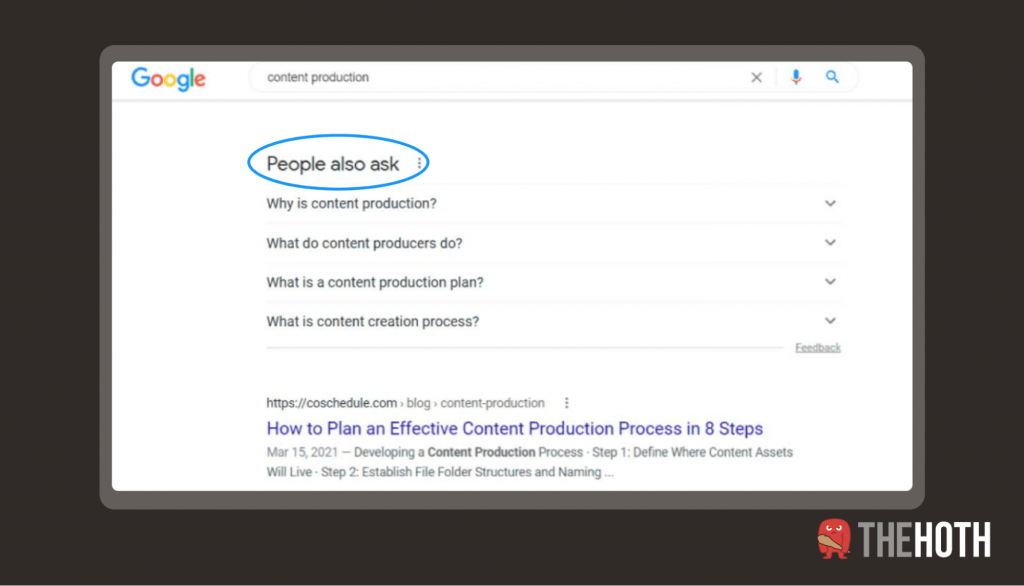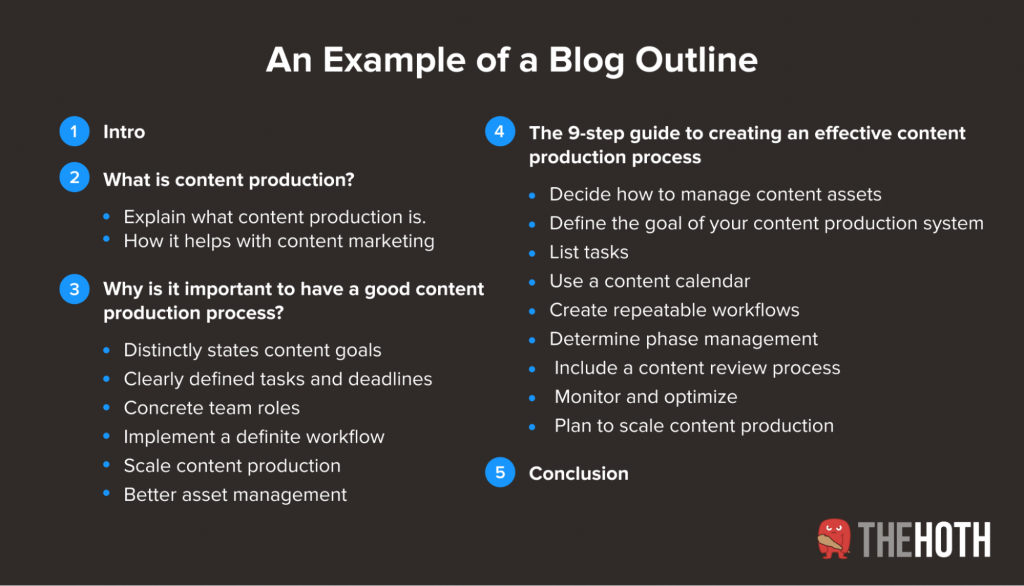Quick Links
Blog posts are the foundation of most content marketing campaigns. The perfect blog or article can enlighten and engage readers while simultaneously highlighting your products.
But great blog posts aren’t made on a whim. They require planning and research. A big part of this process is creating the blog outline.
A blog outline lays out a structure that the writer can follow to create a worthy article, whether they’re crafting the draft today or next week. They make it easy to organize thoughts and ideas into a well-structured and logical blog.
In this article, we explain why blog outlines are essential, provide an easy-to-follow guide on how to write a blog outline, and an example of a blog outline for better understanding.
Why Create a Blog Outline?
When writers are in a hurry or have a packed schedule, it’s tempting to skip the outlining phase and go straight to the draft. But, here’s why you shouldn’t:
#1. Maps out a logical flow
With a blog outline, you can map out the content and ensure it flows logically from one section to another. Think about the content and how it goes from A to B to the final point. Does it make sense?
Outlining lets you answer this question as you figure out how and where to put each heading, which sections can be grouped and how sections relate to each other.
#2. Enables deeper pre-writing research
Creating a logical outline calls for extensive research from writers. It forces them to deeply understand a topic, including all the sub-topics and talking points.
This pre-writing research leads to a better blog post with engaging links, images, statistics, and quotes — all of which can be compiled in the outline. A pre-compiled list of images, links, etc., means you never forget essential points in the draft.
#3. Keeps track of all ideas
Even if the topic you’re writing about is straightforward, it’s easy to miss out on data when there are multiple sources to go through, especially when you go straight to writing.
An outline ensures you never forget any important points from your research when writing your draft. You can jot down all the sub-points under each section and any related ideas.
#4. Provides a clear process and eliminates fluff
A wandering thought process is common when you get into the flow of writing. Often, writers end up focusing heavily on a section that isn’t relevant to the target keywords, or they’ll introduce new ideas randomly.
But when they have a concrete outline to move through, they can easily focus on each section and the notes for it. This prevents them from getting stuck while drafting or veering off into unrelated topics.
#5. Facilitates pre-writing approval
Writers who work on multiple topics simultaneously or freelancers who work with clients have different writing guidelines and editorial processes to follow. An outline review process ensures that everyone is on the same page about formatting, sub-headings, structure, and the content itself.
Sending an outline for approval to an editor or client allows them to provide feedback and suggestions before the writing process starts. It prevents lengthy post-draft edits and potential conflicts after the first draft is finished.
How To Write a Good Blog Outline
The format or structure of your outline can vary depending on the blog topic, editorial guidelines, and more. But, you can use the below steps as a starting point for a universal outline and then customize it to match your topics and content briefs:
#1. Identify the main idea and key points
Every blog post has a primary idea that it focuses on. This is often related to the target keywords for that post.
So, the first step in outlining is to understand the focus of the blog post. What type of blog post is it? It can be a round-up post, an “How to” guide, review, or a comparison post. The type of post makes it easier to understand the main idea.
Let’s look at an example. If the focus keyword is “best marketing software,” your research and brief will likely indicate that it’s a listicle post that focuses on the best X marketing software tools.
This is the purpose of the post. Now, let’s look at the key points. A key point leads readers towards understanding the main idea. It gives the article a sound, logical flow.
So in your “best marketing software” blog post outline, the main idea is a list of the tools, but the key points will relate to why these tools are the best, who should ideally use them, and what makes them stand out to their competitors. It could also include a brief intro to different types of marketing software — like analytics, email autoresponders, social listening tools, and more.
#2. Craft your headline
Create a working headline or post title that perfectly sums up the blog’s intent. Use the points and the main idea from the first step to do this.
There are different kinds of headlines for you to pick from. You can choose to educate with words like “guide, tutorial, strategies,” you can breed distrust while piquing the reader’s interest, for example, “10 Things your Car Dealer Doesn’t Want You To Know”, or round up all the options with “The Ultimate List of X” or “The 25 best X”.
Regardless of the type of headline, the main goal is to reflect the value of your content while engaging readers. You want to pique their interest and make them click through to the post.
Common headline writing tips include:
- Use numbers
- Be specific
- Use powerful words that evoke emotions
- Be concise but descriptive
- Include your main keyword
- Test out different headlines
Since this is still the outline stage, there’s room for experimentation, and you can use a working title to kick things off and refine it later. The main aim here is to understand the topic and the angle of the post well enough to formulate a good working headline.
#3. Come up with a hook
The hook is the first part of the introduction. It’s how you reel users in to read the rest of the blog.
Most introductions follow the Hook, Transition, Thesis model. This is where the first few sentences hook the readers, then transition sentences relate the hook to the main idea of the post, and finally, there’s a thesis or a layout of what’s going to happen in the blog post.
For example, in the introduction of our guide to SEO writing, the hook is that search engine optimization used to be a lot simpler than it currently is, but it’s worded uniquely to make users keep reading.
You need a good hook to get off to a strong start. A boring intro means readers are likely to click away. This decreases ‘dwell time’, which is the length of time a user spends on a page before going back to the search results.
Dwell time is an important Google ranking factor. When readers stay on your pages for a long time, search engines like Google perceive your content as valuable and show it higher in user search results.
#4. Write down all the takeaways
Forget about organization in this step and write all the takeaways you want your readers to get from the blog post, no matter how small they seem. Let your ideas flow and think about the post from the reader’s perspective.
Research is the foundation of this step. Use SERPs (search engine results pages) to understand the topic thoroughly, and then look at the People Also Ask section on Google to see what your target audience is regularly searching for. You want to answer these questions in your post.
Other research avenues include SEO tools like Frase or Clearscope, which can help with the keyword research process, show you the top search results, and formulate a potential outline.
Use all of these research methods and note down any relevant takeaways as you go.
#5. Edit and organize
Break up your takeaways into large sections. Use headers and bulleted lists to build a rough outline. Then, edit this outline to remove unrelated points, combine smaller sections, or reorganize every part so that the post has a natural flow.
You’ll often find that there are more takeaways to be added or a point that needs to be explored further. Alternatively, there might be sections that are too long and don’t focus on the main idea.
You can also cut down any points that you think aren’t valuable or the reader probably already knows.
Decide how long each section will be in this stage, so you stay close to the target word count.
Once there’s a semi-refined outline, you can take it further by editing the takeaways to sound more like headers or sub-headers and organizing all your sections.
#6. Add links, images, and examples
Your outline is almost ready. Once the structure is finalized, you can add additional information under each section and subsection.
This information includes the studies or reports you’ll link to, where you’ll add images, and which points need examples for better understanding. Add a note about the kind of example you’re going to give, so you don’t forget later.
It could be as simple as this note from one of our previous outlines:
Besides external links, writers can also indicate areas to add potential internal links.
Your editor or client can provide feedback on these elements to create a better blog post. For example, they could point out if a study is too old or an image does not match the blog content.
Bonus tip: Once your content outline is ready, go through it and write down any additional notes related to references, formatting, image resolution, etc., so you don’t forget them while drafting. The point of an outline is to streamline draft creation and prevent lengthy edits — these notes help with that.
Blog Outline Example
Here’s an example of a blog outline for our post on content production.
Let’s take a closer look to understand how this article outline was created.
Our research showed that the target readers would want a comprehensive understanding of a content production process and how to create a good one for themselves.
We kicked off the outline with a section on the basics of content production. This is the logical first step, as readers need to know what it is before they can take action.
Next, we underlined the importance of a good content production process. This section drove home the benefits and told users why they should care about the following section, which is about the best practices.
We used the SERPs and the People Also Ask section to determine which points to highlight.
Then we took a deep dive into the best practices for content production. Like the section above, we used SERP for research and came up with nine takeaways.
We organize these logically, so the reader is guided through everything they need before implementing a content production system, how to implement it, and what they can do to improve.
When spread out like this, every element of the outline makes sense. It adds to the blog post and creates value for the reader. This should be the goal.
The outline we’ve shown here is just the start. You can use it as a base to get your own rolling and then customize it. You could flesh out the sections in more detail, add ideas, links, etc.
Map Out Your Blog Posts and Boost Content Quality
A blog outline is to a writer what a map is for a traveler. It lays out where they need to go, how they will get there, and the steps along the way. It helps decide the best path to their destination.
Writers can use the outline to create a logical approach from the intro to takeaways to the conclusion. Of course, you can use your new outlining process to improve any piece of content, not just blog posts or articles.
While creating individual outlines and blog posts internally can work for a smaller-scale content production process, it’s often difficult to scale. If you want to scale up your content and earn authority and search rankings, you can rely on HOTH Blogger, our professional blog writing service.















it’s an informative article and an excellent presentation